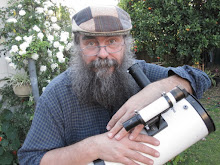Monday, December 08, 2025
Thursday December 11 to Thursday December 18
The Last Quarter Moon is Friday December 12. Saturn is high in the north-western sky. Jupiter is visible in the morning sky near the bright star Pollux. Jupiter is rising before midnight. Jupiter is still best in the morning. Geminid meteor shower 14th and 15th. Mercury is visible deep in the twilight near the Moon on the 18th.
The Last Quarter Moon is Friday December 12. The Moon is at apogee, when it is furthest from the Earth, on the 17th.
Jupiter is passing through Gemini and is near the bright star Pollux. Jupiter forms a slightly battered line with the bright stars Castor, Pollux and Procyon.
The inset is the telescopic view Jupiter at this time.
Mercury is just visible in the twilight. It is near the crescent Moon on the 18th.
Venus is lost in the twilight glow.
Mars is lost in the twilight.
Jupiter climbs in the morning twilight and is now rising just before midnight. Jupiter forms a slightly battered line with the bright stars Castor, Pollux and Procyon.
Saturn is the brightest object in the north-western skies.
Star Map via Virtual sky. Use your mouse to scroll around and press 8 when your pointer is in the map to set to the current time.
Cloud cover predictions can be found at SkippySky.
Here is the near-real time satellite view of the clouds (day and night) http://satview.bom.gov.au/
Labels: weekly sky
Geminid Meteor Shower 13-15 December 2025
| The northern horizon at 3:13 am ACDST as seen from Adelaide on Sunday December 14 when the Geminid radiant is at its highest. The Geminid radiant is marked with a starburst. Similar views will be seen elsewhere in Australia at a similar latitude and the equivalent local time. (click to embiggen). | The northern horizon at 1:46am AEST as seen from Brisbane on on Sunday December 14 when the Geminid radiant is at its highest. The Geminid radiant is marked with a starburst. Similar views will be seen elsewhere in Australia at a similar latitude and the equivalent local time. (click to embiggen). | The northern horizon at 3:17 am AEDST as seen from Melbourne on Sunday December 14 when the Geminid radiant is at its highest. The Geminid radiant is marked with a starburst. Similar views will be seen elsewhere in Australia at a similar latitude and the equivalent local time. (click to embiggen). |
This year is a modest year for the Geminid meteor shower. The Geminids are
an unusual meteor shower in that their parent body is 3200 Phaethon,
an asteroid, rather than a comet. It is speculated though that Phaeton
is actually a "gassed out" comet, and so the debris that makes up the
Geminids may still be cometary particles, but is more likely broken rock
fragments from its close approach to the sun.
The Geminids are usually a fairly reliable meteor shower but this year there will be some interference from the Moon.
The Geminids have a broad peak and normally show good activity
well before and after the peak on
the day before and after. The nominal peak is December 14, 08h UT, that means in Australia this year most of the activity is concentrated on the morning of the 14th after sunrise, but there will still be decent rates before twilight, and on the 15th as well.
As the radiant doesn't rise until just before midnight (daylight saving time) in most of Australia and the radiant is highest (with the best meteor rates) in the early hours in a narrow band around 3 am local time, so you are going to lose some sleep for this. Fortunately this is a Sunday, so you can sleep in after.
You can find predictions for your local site at the meteor flux estimator (choose 4 Geminids and date 13-14 December, don't forget to change the date to 2025). You will have to enter your local latitude and longitude for your site. I have also made a table for major cities below.
Unfortunately, both Chrome and Firefox have changed their security settings to prevent plugins from running, and the flux estimator only runs under Internet Explorer now OR Edge in Internet Explorer mode (click on the triple dots once the page has loaded ), you have to have the JAVA plug-in loaded.
You can follow the progress of the shower at the IMO Geminids Live page.
At 3.00 am in the morning AEDST (midnight, AEST) Castor (alpha Geminorum) is about four hand-spans above the horizon and almost due north. Pollux, the other twin, is less than a hand-span to the right again and below Castor. The radiant is just below Pollux. The best rates are when the radiant is highest, when it is due north, the Moon is low to the horizon and before astronomical twilight. This is around 3:30 am ACDST Adelaide ~3:00 ACST Darwin, ~1-1:30 am local time Perth and Brisbane and ~ 2:30-3:00 am AEDST Melbourne, Sydney and Hobart.
| City | Time Radiant Highest | Moon Rise | Astronomical Twilight |
| Adelaide ACDST | 3:13 | 2:09 | 4:09 |
| Brisbane AEST | 1:46 | 1:43 | 3:14 |
| Darwin ACST | 2:43 | 2:51 | 4:57 |
| Hobart AEDST | 2:38 | 1:24 | 2:39 |
| Melbourne AEDST | 3:17 | 2:08 | 4:00 |
| Perth AWST | 2:13 | 2:11 | 3:25 |
| Sydney AEDST | 2:52 | 1:46 | 3:56 |
When you get up, allow at least 5 minutes for your eyes to adjust and become dark adapted (even if you have stumbled out of bed in the dark, here's some hints on dark adaption of your eyes so you can see meteors better).
Be patient, it may be several minutes before you are rewarded with you first meteor, then a couple will come along in quick succession (a meteor every 2 minutes is an average, they won't turn up like a ticking clock but more or less randomly).
|
Locations on the same latitude as... |
Morning December 13 |
Morning December 14 (UT peak) |
Morning December 15 |
Morning December 16 |
|
Darwin |
14 meteors/hr |
36 meteors/hr |
29 meteors/hr |
7 meteors/hr |
|
Brisbane/Perth |
9 meteors/hr |
23 meteors/hr |
23 meteors/hr |
6 meteors/hr |
|
Sydney/Adelaide/Canberra |
7 meteors/hr |
23 meteors/hr |
23 meteors/hr |
4 meteors/hr |
|
Melbourne |
6 meteors/hr |
15 meteors/hr |
14 meteors/hr |
2 meteors/hr |
|
Hobart |
4 meteors/hr |
11 meteors/hr |
11 meteors/hr |
2 meteors/hr |
A lawn chair or something similar will make your observing comfortable (or a picnic rug spread on the ground and a nice pillow), and having a Thermos of hot coffee, tea or chocolate to swig while watching will increase your comfort. Despite it being summer, make sure you have a jumper or something as the night can still get cold. Also, plenty of insect repellent is a good idea.
Guides to taking meteor photos are here and here.
As well, Orion and the Hyades will be visible, with Jupiter just above Castor and Pollux. So it will be a quite nice morning for sky watching. Keep an eye out for satellites! There may be a bright ISS pass on the morning of the 15th from your location.
Cloud cover predictions can be found at SkippySky.
Here is the near-real time satellite view of the clouds (day and night) http://satview.bom.gov.au/
Labels: geminids, Meteors, unaided eye
Wednesday, December 03, 2025
Thursday December 4 to Thursday December 11
The Full Moon is Friday December 5. This is a perigee ("super") Full Moon. Saturn is high in the north-western sky. Jupiter is visible in the morning sky near the bright star Pollux. Jupiter is rising before midnight and is close to the waning moon on the 7th. Jupiter is still best in the morning.
The Full Moon is Friday December 5. This is a perigee ("super") Full Moon. The Moon is at Perigee, when it is closest to the Earth, on the 4th.
Jupiter is passing through Gemini and is near the bright star Pollux. Jupiter forms a slightly battered line with the bright stars Castor, Pollux and Procyon. The waning Moon joins the lineup below Jupiter.
The inset is the telescopic view Jupiter at this time.
The differences are in Full Moon size are subtle.
It requires a keen eye and good memory to distinguish a perigee "super" Moon from more ordinary moons, the best contrast is with the apogee "mini" moon of April 13.
Still, it is a good excuse to get people out and looking at the Moon, which will be beautiful . Make sure you are not fooled by the Moon Illusion.
Mercury is lost in the twilight
Venus is lost in the twilight glow.
Mars is lost in the twilight.
Jupiter climbs in the morning twilight and is now rising just before midnight. Jupiter forms a slightly battered line with the bright stars Castor, Pollux and Procyon. The Moon joins Jupiter on the 7th-8th
Saturn is the brightest object in the north-western skies.
Star Map via Virtual sky. Use your mouse to scroll around and press 8 when your pointer is in the map to set to the current time.
Cloud cover predictions can be found at SkippySky.
Here is the near-real time satellite view of the clouds (day and night) http://satview.bom.gov.au/
Labels: weekly sky
Monday, December 01, 2025
December skies 2025
https://soundcloud.com/astrophiz/novemberskyguide224 Eastern sky on Sunday, December 7 as seen from Adelaide at 23:52 ACDST. Jupiter is rising and is close to the waning Moon.
| December | |
| 5 December 2025 | Perigee Full Moon ("super" Moon) |
| 7 December 2025 | Jupiter near waning Moon (4° apart) in morning sky, forming a line with the bright star Pollux. |
| 14/15 December 2025 | Geminid Meteor shower in the morning, some Moon interference |
| 19 December 2023 | Mercury, the thin Crescent Moon and the bright star Antares from a triangle low in the morning twilight, might need binoculars |
| 22 December 2025 | Earth is at Solstice |
| 27 December 2025 | Nearly First Quarter Moon near near Saturn (4° apart) in the early evening sky |
Moon:
| December 4 | Moon at perigee |
| December 5 | Full Moon (perigee full Moon) |
| December 12 | Last Quarter Moon (ideal for star gazing) |
| December 17 | Moon at apogee |
| December 20 | New Moon (also ideal for star gazing) |
| December 28 | First Quarter Moon |
Meteor Shower:
Geminids December the 14th contends with a last Quarter moon.
| Locations on the same latitude as... | December 12 | December 13 | December 14 (peak) | December 15 |
| Darwin | 7 meteors/hr | 14 meteors/hr | 36 meteors/hr | 29 meteors/hr |
| Brisbane/Perth | 5 meteors/hr | 9 meteors/hr | 23 meteors/hr | 23 meteors/hr |
| Sydney/Adelaide/Canberra | 4 meteors/hr | 7 meteors/hr | 18 meteors/hr | 16 meteors/hr |
Sky looking south on Saturday December 20 s seen from Adelaide at 22:15 ACDST (90 minutes after sunset).
Similar views will be seen from the rest of Australia at roughly the equivalent local time (90 minutes after sunset).
Stars:
In the Southern sky the dwarf galaxies, the Magellanic clouds, are rising. The Large Magellanic cloud will be in an excellent viewing position in the late evening. The Large Magellanic cloud and the Tarantula nebula are magnificent objects.
If you look due South after astronomical twilight (and hour and a half after sunset) in a dark sky location you will see what looks like two wispy clouds but unlike clouds they don’t move, these are the Magellanic clouds, the dwarf companion galaxies to ours. The largest of the wisps, to the left of due south is the large Magellanic cloud. The Large Magellanic cloud lies at an approximate distance of 163,000 light years from us. The LMC has a prominent bar in its central region, which indicates that it may have previously been a barred spiral galaxy.
A line through Sirius and Canopus carried on will piece the heart of the LMC. Within the hazy disk of the LMC is a fuzzy star, this is the tarantula nebula. While it is not much to the unaided eye, and a mere fuzzy patch in binoculars, in a telescope it is outstanding. It is the most active star-forming region in the 30-odd galaxies including the Milky Way that make up the Local Group In a telescope you can see the spidery appearance for which it is named, a dozen or so incredibly hot massive stars at the centre of long tendrils of hot gas (why not octopus?).
There are also multiple open clusters and nebula and a globular cluster to explore with binoculars, so you can spend quite a bit of time on the LMC alone. In a telescope they are even better. Just south of the Tarantula nebula is a complex of clusters that repays exploration.
As well, the skies feature Orion the Hunter striding across the sky, The distinctive V shape of the Taurus the bull, and the beautiful Pleiades cluster. For us in the southern hemisphere the Pleaides are almost due moth at astronomical twilight. Try counting how many stars you see. Another name for the Pleiades is the seven sisters, can you see seven stars?
The Southern Pleiades, a group of stars clustered around the star theta carina, is now readily visible two hand-spans above the southern cross.
The Christmas holiday season will be a fantastic time to explore our skies.
Labels: Monthly sky, unaideed eye
Monday, November 24, 2025
Thursday November 27 to Thursday December 4
The First Quarter Moon is Friday November 28. The Lunar X is visible on the 27th. Saturn is high in the north-western sky and is close to the waxing moon on the 28th. Jupiter is visible in the morning sky near the bright star Pollux. Jupiter is rising before midnight but is still best in the morning.
The First Quarter Moon is Friday November 28. The Lunar X is visible on the 27th.The Moon is at Perigee, when it is closest to the Earth, on the 4th.
Jupiter is passing through Gemini and is near the bright star Pollux. Jupiter forms a slightly battered line with the bright stars Castor, Pollux and Procyon.
The inset is the telescopic view Jupiter at this time.
Western sky on the evening of Thursday, November 27 as seen from Adelaide at 21:15 ACDST (60 minutes after sunset, click to embiggen).
The Lunar X and V are visible on the nearly first Quarter Moon (see telescopic view inset)
Similar views will be seen from the rest of Australia at roughly the equivalent local time (60 minutes after sunset).
Mercury is lost in the twilight
Venus is lost in the twilight glow.
Mars is lost in the twilight.
Jupiter climbs in the morning twilight and is now rising just before midnight. Jupiter forms a slightly battered line with the bright stars Castor, Pollux and Procyon.
Saturn is the brightest object in the north-western skies. It is close to the waxing Moon on the 29th.
Star Map via Virtual sky. Use your mouse to scroll around and press 8 when your pointer is in the map to set to the current time.
Cloud cover predictions can be found at SkippySky.
Here is the near-real time satellite view of the clouds (day and night) http://satview.bom.gov.au/
Labels: weekly sky
Tuesday, November 18, 2025
Thursday November 20 to Thursday November 27
The New Moon is Thursday November 20. Mercury is lost in the twilight. Mars is near the thin crescent moon on the 21st deep in the twilight. Saturn is high in the north-western sky. Jupiter is visible in the morning sky near the bright star Pollux. Jupiter is rising before midnight but is still best in the morning.
The New Moon is Thursday November 20. The Moon is at apogee, when it is furthest from the earth, on the 20th.
Jupiter is passing through Gemini and is near the bright star Pollux. Jupiter forms a slightly battered line with the bright stars Castor, Pollux and Procyon.
The inset is the telescopic view Jupiter at this time.
The thin crescent Moon is close to Mars low in the twilight, you will need binoculars to see Mars.
Similar views will be seen from the rest of Australia at roughly the equivalent local time (30 minutes after sunset).
Mercury is lost in the twilight
Venus is lost in the twilight glow.
Mars meets the thin crescent Moon deep in the twilight on the 21st.
Jupiter climbs in the morning twilight and is now rising just before midnight. Jupiter forms a slightly battered line with the bright stars Castor, Pollux and Procyon.
Saturn is the brightest object in the north-western skies.
Star Map via Virtual sky. Use your mouse to scroll around and press 8 when your pointer is in the map to set to the current time.
Cloud cover predictions can be found at SkippySky.
Here is the near-real time satellite view of the clouds (day and night) http://satview.bom.gov.au/
Labels: weekly sky
Tuesday, November 11, 2025
Thursday November 13 to Thursday November 20
The New Moon is Thursday November 20. Mercury meets Mars deep in the twilight on the 13th. Then Mercury is lost in the twilight. Saturn is high in the northern sky. Jupiter is visible in the morning sky near the bright star Pollux. Comet C/2025 A6 (Lemon) may be visible in binoculars.
The New Moon is Thursday November 20. The Moon is at apogee, when it is furthest from the earth, on the 20th.
Jupiter is passing through Gemini and is near the bright star Pollux. Jupiter forms a slightly battered line with the bright stars Castor, Pollux and Procyon.
The inset is the telescopic view Jupiter at this time.
Mercury is close to Mars is low in the twilight, you may need binoculars to see them.
It is possible comet C/2025 A6 (lemon) may be visible in binoculars.
Similar views will be seen from the rest of Australia at roughly the equivalent local time (60 minutes after sunset).
Mercury is lost in the twilight. Mars is in the head of the Scorpion just above the horizon.
It is possible comet C/2025 A6 (lemon) may be visible in binoculars not far from eta Ophiuchus.
Similar views will be seen from the rest of Australia at roughly the equivalent local time (60 minutes after sunset).
Mercury meets Mars deep in the twilight on the 13th then is lost in the twilight.
Venus is lost in the twilight glow.
Mars meets Mercury deep in the twilight on the 13th.
Jupiter climbs in the morning twilight. Jupiter forms a slightly battered line with the bright stars Castor, Pollux and Procyon.
Saturn is the brightest object in the northern skies.
Star Map via Virtual sky. Use your mouse to scroll around and press 8 when your pointer is in the map to set to the current time.
Cloud cover predictions can be found at SkippySky.
Here is the near-real time satellite view of the clouds (day and night) http://satview.bom.gov.au/
Labels: weekly sky
Wednesday, November 05, 2025
Thursday November 6 to Thursday November 13
The Last Quarter Moon is Wednesday November 12. Mercury is not far from the bright star Antares, then falls back towards the horizon and meets Mars deep in the twilight on the 13th. Saturn is high in the northern sky. Jupiter is visible in the morning sky near the bright star Pollux and is close to the waning moon on the 11th.
The Last Quarter Moon is Wednesday November 12.
Jupiter is passing through Gemini and is near the bright star Pollux. Jupiter forms a slightly battered line with the bright stars Castor, Pollux and Procyon. The waning Moon is close to Jupiter at this time.
The inset is the telescopic view Jupiter at this time.
Mercury is below bright Antares. Mars is in the head of the Scorpion near delta Scorpii.
It is possible comet C/2025 A6 (lemon) may be visible in binoculars not far from Antares.
Similar views will be seen from the rest of Australia at roughly the equivalent local time (60 minutes after sunset).
Mercury is close to Mars is low in the twilight, you may need binoculars to see them.
It is possible comet C/2025 A6 (lemon) may be visible in binoculars.
Similar views will be seen from the rest of Australia at roughly the equivalent local time (60 minutes after sunset).
Mercury is not far from the bright star Antares, then falls back towards the horizon an meets Mars deep in the twilight on the 13th.
Venus is lost in the twilight glow.
Mars meets Mercury deep in the twilight on the 13th. .
Jupiter climbs in the morning twilight. Jupiter forms a slightly battered line with the bright stars Castor, Pollux and Procyon. Jupiter is close to the waning moon on the 11th.
Saturn is the brightest object in the northern skies.
Star Map via Virtual sky. Use your mouse to scroll around and press 8 when your pointer is in the map to set to the current time.
Cloud cover predictions can be found at SkippySky.
Here is the near-real time satellite view of the clouds (day and night) http://satview.bom.gov.au/
Labels: weekly sky






































 Click to read about or order
Click to read about or order Click to read about or order
Click to read about or order Click to read about or order
Click to read about or order Click to read about or order
Click to read about or order




